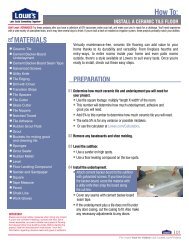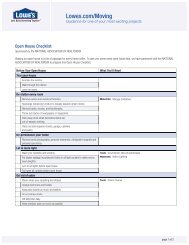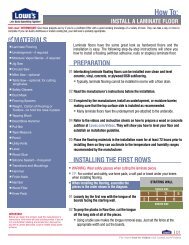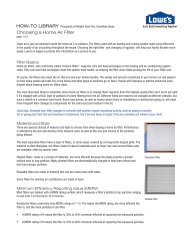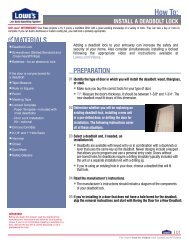You also want an ePaper? Increase the reach of your titles
YUMPU automatically turns print PDFs into web optimized ePapers that Google loves.
PREPARATION (cont.)<br />
<strong>How</strong> <strong>To</strong> <strong>Build</strong> a <strong>Deck</strong>:<br />
Part 5 – BUILDING DECK STAIRS<br />
05 Use paper, pencil, level, framing square and tape measure to calculate a stairway<br />
run, the horizontal depth of the steps. Most building codes call for a minimum<br />
run of 9", but 11-12" may work better. The rise or vertical distance between<br />
the tread is typically about 7".<br />
TIP: A shorter rise is usually more comfortable with a deeper run, and a taller<br />
rise works better with a shorter run. A good rule to follow is the sum of the<br />
rise plus the run should equal about 17-½".<br />
1. Calculate the total rise of the stairway directly over the landing. Extend a level or straight 2x4 from<br />
the deck surface and take the measurement to the ground below. In our video, the total rise is 34".<br />
2. Divide this measurement by 7", the ideal height for each step. Round this number<br />
to the nearest whole number to get the number of risers. In our video,<br />
the number of risers is 5.<br />
3. Divide the total rise by the number of risers. For our example, we divide 34" by 5 to<br />
get the actual height of those risers, in this case, 6- 7 /8". If the result is too short for<br />
your preference, reduce the number of risers by 1 and calculate again.<br />
4. Calculate the run. The example uses two 5/4x6 decking planks for the tread, with<br />
drainage gaps about 1 /8". We added toe-kicks on the back of each step for a cleaner<br />
look. In the example, the unit run will be 11". Refer to your deck building plans for<br />
details on the run.<br />
06 Calculate the length of the stringers.<br />
1. Refer to a framing square.<br />
One side is marked in 12ths, allowing you to scale 1' down to 1". For instance, 8'<br />
on a framing square is marked at the 8" line. The smaller lines are inch marks that<br />
make up one foot.<br />
2. Calculate the total run (number of treads x individual run = total run).<br />
The example total run is 5 treads x 11" = 55" or 4' 7". Hold the end of a tape<br />
measure along the left side of the square at 4' 7" or your calculated total run mark.<br />
3. Locate the total rise (determined in 05-1 above).<br />
In the example, it is 34" (see above) or 2' 10". While still holding the end of the<br />
tape measure on the left side, move the tape to the 2' 10" mark on the right side<br />
of the framing square.<br />
4. With the tape measure on these two marks, take note of the measurement and<br />
hold it along the framing square. It will show you the minimum length for the<br />
stringers. In the example: 5' 3", so you will cut the stringers from two 6' planks.<br />
02<br />
For more how-to videos visit Lowes.com/Videos



